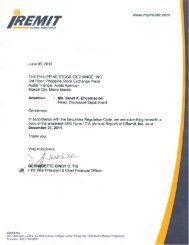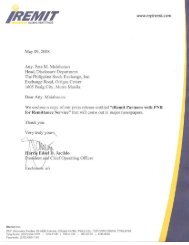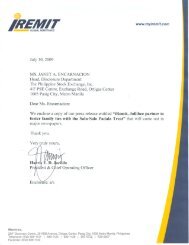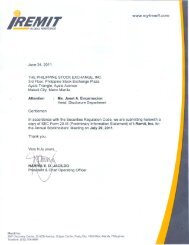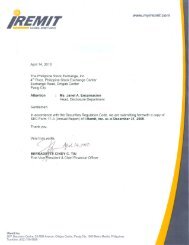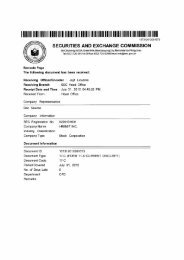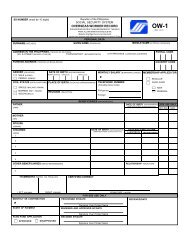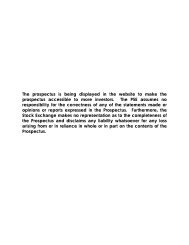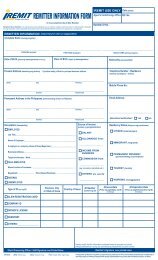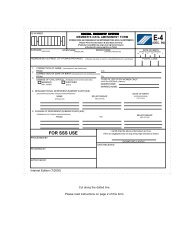SEC Form 20-IS - iRemit Global Remittance
SEC Form 20-IS - iRemit Global Remittance
SEC Form 20-IS - iRemit Global Remittance
Create successful ePaper yourself
Turn your PDF publications into a flip-book with our unique Google optimized e-Paper software.
- 24 -<br />
As of December 31, <strong>20</strong>11, accounts receivable and other receivables are carried in the<br />
consolidated balance sheet at P=0.93 billion and P=0.11 billion, respectively (see Notes 8 and 9).<br />
As of December 31, <strong>20</strong>10, accounts receivable and other receivables are carried in the<br />
consolidated balance sheet at P=1.06 billion and P=0.08 billion, respectively. The Group has<br />
assessed that there is no need to recognize impairment losses on its receivables as of<br />
December 31, <strong>20</strong>11 and <strong>20</strong>10.<br />
b. Impairment of nonfinancial assets<br />
(i) Investments in associates<br />
The Group assesses impairment on its investments in associates whenever events or<br />
changes in circumstances indicate that the carrying amount of the assets may not be<br />
recoverable. Among others, the factors that the Group considers important, which could<br />
trigger an impairment review on its investments in associates, include the following:<br />
• deteriorating or poor financial condition;<br />
• recurring net losses; and<br />
• significant changes with an adverse effect on the associate have taken place during the<br />
period, or will take place in the near future, in the technological, market, economic, or<br />
legal environment in which the associate operates.<br />
(ii) Goodwill<br />
The Group determines whether goodwill is impaired at least on an annual basis. This<br />
requires an estimation of the recoverable amount, which is the higher of the net selling<br />
price or value in use of the CGU to which the goodwill is allocated.<br />
The Group’s impairment test for goodwill is based on value in use calculations that use a<br />
discounted cash flow model. The cash flows are derived from the budget for the next five<br />
years and do not include restructuring activities that the Group is not yet committed to or<br />
significant future investments that will enhance the asset base of the CGU being tested.<br />
The recoverable amount is most sensitive to the discount rate used for the discounted cash<br />
flow model as well as the expected future cash-inflows and the growth rate used for<br />
extrapolation purposes.<br />
(iii) Property and equipment and software costs<br />
The Group assesses impairment on property and equipment and software costs whenever<br />
events or changes in circumstances indicate that the carrying amount of the asset may not<br />
be recoverable. The factors that the Group considers important, which could trigger an<br />
impairment review, include the following:<br />
• significant underperformance relative to expected historical or projected future<br />
operating results;<br />
• significant changes in the manner of use of the acquired assets or the strategy for<br />
overall business; and<br />
• significant negative industry or economic trends.<br />
The Group recognizes an impairment loss whenever the carrying amount of the asset<br />
exceeds its recoverable amount. The recoverable amount is determined based on the<br />
asset’s value in use computation, which considers the present value of estimated future<br />
cash flows expected to be generated from the continued use of the asset.<br />
*SGVMC116502*



